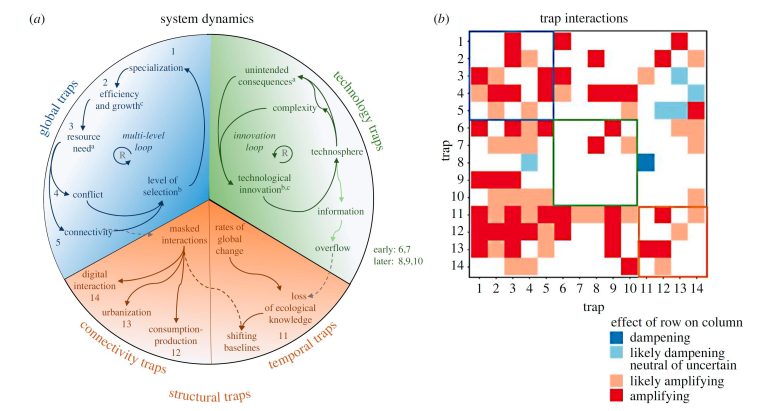
A new study reveals that humanity is at risk of falling into 14 evolutionary dead ends, termed “evolutionary traps,” ranging from climate change to artificial intelligence. The research, focusing on the Anthropocene era, highlights the need for global cooperation and active societal transformation to avoid these traps.
Misaligned AI is not the one you should worry most about (yet).
For the first time, scientists have used the concept of evolutionary traps on human societies at large. They find that humankind risks getting stuck in 14 evolutionary dead ends, ranging from global climate tipping points to misaligned artificial intelligence, chemical pollution, and accelerating infectious diseases.
The Anthropocene Era: Success and Challenges
The evolution of humankind has been an extraordinary success story. But the Anthropocene — the proposed geological epoch shaped by us humans — is showing more and more cracks. Multiple global crises, such as the COVID-19 pandemic, climate change, food insecurity, financial crises, and conflicts have started to occur simultaneously in something that scientists refer to as a polycrisis.

(a) System dynamics associated with three major groups of Anthropocene traps, global traps, technology traps and
structural traps (including temporal and connectivity traps). Two reinforcing feedback loops are indicated with R and interactions between dynamics across groups of traps are indicated with colored superscript letters (color of causal node) and stippled lined arrows.
(b) A heatmap of the interactions between outcomes of the 14 proposed Anthropocene traps.
Credit: Philosophical Transactions of the Royal Society B
Human Creativity and Unintended Consequences
“Humans are incredibly creative as a species. We are able to innovate and adapt to many circumstances and can cooperate on surprisingly large scales. But these capabilities turn out to have unintentional consequences. Simply speaking, you could say that the human species has been too successful and, in some ways, too smart for its own future good,” says Peter Søgaard Jørgensen, researcher at the Stockholm Resilience Centre at Stockholm University and at the Royal Swedish Academy of Sciences’ Global Economic Dynamics and the Biosphere program and Anthropocene laboratory.

Peter Søgaard Jørgensen is lead author of the study. He isa researcher at the Stockholm Resilience Centre at Stockholm University and at the Royal Swedish Academy of Sciences’ Global Economic Dynamics and the Biosphere programme and Anthropocene laboratory.
Credit: Stockholm Resilience Centre
A Landmark Study on Evolutionary Traps
He is the lead author of a new landmark study published today as part of a larger assessment in the journal Philosophical Transactions of the Royal Society B. The assessment gathers insights from a wide range of different scientific disciplines across the natural and social sciences and humanities, to understand how the Anthropocene evolved and how global sustainability can continue to evolve in the future.
Identifying and Understanding Evolutionary Traps
The new study shows how humanity could get stuck in “evolutionary traps” — dead ends that occur from initially successful innovations. In a first scoping effort, they identify 14 of these, including the simplification of agriculture, economic growth that does not deliver benefits for humans or the environment, the instability of global cooperation, climate tipping points, and artificial intelligence (for a full list of traps see table further down).
Evolutionary Traps in the Animal World and Human Societies
“Evolutionary traps are a well-known concept in the animal world. Just like many insects are attracted by light, an evolutionary reflex that can get them killed in the modern world, humankind is at risk of responding to new phenomena in harmful ways,” explains Peter Søgaard Jørgensen.
The simplification of agricultural systems is an example of such a trap. Relying on a few highly productive crops such as wheat, rice, maize, and soya, has meant that calories produced have skyrocketed over the past century. But it also meant that the food system has become very vulnerable to environmental change, such as weather extremes, or new diseases.
The Severity and Interconnectivity of Traps
Of the 14 evolutionary traps, 12 are in an advanced state, meaning that humankind is on the verge of getting stuck to a degree where it becomes very difficult to get out. What’s more, societies are continuing to move in the wrong direction in 10 of these 14. Alarmingly, these evolutionary traps tend to reinforce each other. If societies get stuck in one dead end, they are more likely to get stuck in others as well. The two dead ends that currently are less advanced are the autonomy of technology – AI and robotics – and a loss of social capital through digitalization.

Lan Wang Erlandsson, is a co-author and researcher at the the Stockholm Resilience Centre at Stockholm University and the Royal Swedish Academy of Sciences’ Anthropocene laboratory. Credit: Stockholm Resilience Centre
The new assessment also looks into why societies struggle so hard to move out of these traps.
Global Challenges and the Need for Collaboration
“The evolutionary forces that created the Anthropocene do not work well at the global level. In today’s global systems, social and environmental problems grow in places that seem distant to the societies that could prevent them. Also, addressing them often requires global collaboration on a scale that many evolutionary forces often do not align well with,” says co-author Lan Wang-Erlandsson, researcher at the Stockholm Resilience Centre at Stockholm University and the Royal Swedish Academy of Sciences’ Anthropocene laboratory.
A Call to Action for Humanity
This does not mean that humanity is doomed to fail, argue the researchers. But we must start to transform our societies actively. So far, the Anthropocene has to a large extent been an unconscious byproduct of other evolutionary processes.
“It’s time for humans to become aware of the new reality and to collectively move where we want to as a species. We have the capability to do that and are already seeing signs of such movements. Our creativity, and our power to innovate and collaborate equip us with the perfect tools to actively design our future. We can break out of dead ends and business-as-usual, but for that, we must nurture the capacity for collective human agency and design settings where it can flourish,” explains Peter Søgaard Jørgensen.
He continues: “A very simple thing that everybody can do is to engage more in nature and society while also learning about both the positive and negative global consequences of our own local actions. There’s nothing better than exposing yourself to what needs protecting.”
Reference: “Evolution of the polycrisis: Anthropocene traps that challenge global sustainability” by Peter Søgaard Jørgensen, Raf E. V. Jansen, Daniel I. Avila Ortega, Lan Wang-Erlandsson, Jonathan F. Donges, Henrik Österblom, Per Olsson, Magnus Nyström, Steven J. Lade, Thomas Hahn, Carl Folke, Garry D. Peterson and Anne-Sophie Crépin, 1 January 2024, Philosophical Transactions of the Royal Society B.
DOI: 10.1098/rstb.2022.0261









The international organization that approves the definitions of new geological divisions has not given their blessing to the proposed term ‘Anthropocene.’ It gives me pause as to what motivates people who consider themselves scientists — classically, disinterested observers seeking to understand the world we live in — to accept and talk about the Anthropocene as though it is an accepted definition. Are they proselytes advocating the acceptance of the term, and thereby betraying the expected ‘disinterested’ or objective behavior of a scientist, or do they just have an oversized ego that drives them to ignore the expected behavior of a scientist and behave as though they are the final word on definitions that are expected to be accepted and used by geologists? Whatever their personal motivation, they are using a term that has not been defined and are contributing to a virtual Tower of Babel.
It is ironic that those promoting Anthropogenic Global Warming, claim consensus among climatologists, and yet there are many, such as these authors, who apparently have no respect for consensus. That is well and good for hypotheses which should survive or be rejected on the merit of the facts and logic supporting them. However, it is an entirely different thing for a vocabulary that requires a mutually agreed upon meanings to communicate ideas.
While it seems you may be technically correct, you may be missing the forest for the trees.
from https://en.wikipedia.org/wiki/Anthropocene
Ecologist Eugene F. Stoermer subsequently used “anthropocene” with a different sense in the 1980s[17] and the term was widely popularised in 2000 by atmospheric chemist Paul J. Crutzen,[11] who regards the influence of human behavior on Earth’s atmosphere in recent centuries as so significant as to constitute a new geological epoch. Stoermer wrote, “I began using the term ‘anthropocene’ in the 1980s, but never formalised it until Paul contacted me.”[18] Crutzen has explained, “I was at a conference where someone said something about the Holocene. I suddenly thought this was wrong. The world has changed too much. So I said: ‘No, we are in the Anthropocene.’ I just made up the word on the spur of the moment. Everyone was shocked. But it seems to have stuck.”
the Anthropocene Working Group (AWG) of the Subcommission on Quaternary Stratigraphy (SQS) of the ICS voted in April 2016 to proceed towards a formal golden spike (GSSP) proposal to define the Anthropocene epoch in the geologic time scale (GTS) and presented the recommendation to the International Geological Congress in August 2016.”
I say, get with the program.
I’ve had no luck fact-checking Clyde Spencer. It would be like bringing an accordion to a gunfight; he knows his stuff. The phrase anthroposcene shouldn’t be in serious research published by the Royal Society. To be fair, this paper is on how time and change and socializing and needing food and money are entirely new ‘traps’ creating an evolutionary ‘polycrisis’ for our systemic equity, so it’s already not particularly serious research. Anyway, if I think about that any deeper, I’ll be sad about the Royal Society.
I like the turn of phrase in anthroposcene and I use it. It’s pithy, cute, with a hint of truth. It’s shorthand saying that now is all about us, that we define a whole new global geological epoch. Absurd, and it’s conceited, but I enjoy that. It’s unfortunately being used as a short-term pejorative political phrase, making it one humbling asteroid or supervolcano or cold year away from being a very very short epoch. And I use it, but I still prefer common chemical names and say Pluto is a planet. International organizations say they change the meanings of words, but they don’t for my purpose of communication. Yet if I were publishing formalized research, accepted vocabulary is the way to go to maximize understanding and accuracy, even if the IGC will likely be silly eventually accepting this term to get attention.
Thank you for your support and compliment. Truth be known, my accuracy is a result of a disability. My memory is not what it once was. However, I’m aware of the problem. Therefore, if I’m not absolutely certain of something, I check what I think to be the truth before committing it to ASCII, as represented by encoded electrons.
“Use an accordion, go to jail.”
“… and presented the recommendation to the International Geological Congress in August 2016.”
Seven years ago and the recommendation to the IGC has not been passed. There are reasons for that. If there were a serious error in the stratigraphy or the nomenclature, it would receive priority. Instead, there is resistance. Perhaps one of the reasons is that outside political groups are attempting to manipulate something critical to understanding long-time — the purview of paleontologists and historical geologists — in order to advance their political agenda. I’m reminded of the remark by Mark Twain that he had been on the verge of being an angel his whole life. “Anthropocene” may be on the verge of being accepted your whole life.
With respect to getting with the program, you might read the following for your edification: https://wattsupwiththat.com/2018/08/13/blow-to-warmists-the-proposed-anthropocene-epoch-has-been-denied-by-ics/
Geologist David Middleton has ridiculed the ‘Anthropocene’ extensively. For his most recent contribution to levity, see this: https://wattsupwiththat.com/2023/07/13/the-last-gasp-of-the-anthropocene/ . In the unlikely event that you enjoy his style of poking people in the ribs with his intellectual elbow, when he finds them to be too full of themselves, just do a search for “Anthropocene” at WUWT.
Ovecrpopulation is multiplying these evolutionary traps, but fate of human species is part of natural evolution process towards the next candidate to evolve and their era to replace human species on the planet.
One obvious problem with this study is the fact that the threats were identified by a small number of academics who, no doubt, share a similar view of the world and thus share many blind spots.
An obvious threat that they have missed is socialism / autocracy. One of today’s major problems is the creeping socialism of the West’s democracies and the threat of a new dark age if socialism were to triumph.
This does not mean that humanity is doomed to fail, argue the researchers.”
This is classic hope porn, a form of insanity which is part of why humanity is doomed.
Of course humanity is doomed once one understands the historical background that got us here:
https://www.rolf-hefti.com/covid-19-coronavirus.html
I don’t understand all the hullabaloo about “anthropocene”. The term only means that humans have become a force which will, in later years (like millions of later years), be visible in the geological record (assuming whatever intelligent beings exist in a few millions of years or or more on earth – possibly ones we evolve into – do geology as we know it, and look for evidence of our existence in the rocks).
Why is this even controversial? Of course they’ll see the plastics and other chemical compounds in the rocks from our existence. They’ll be able to see the rapid rise of CO2
and date it concurrent with fossil remains of our bodies. They’ll be able to see the crushed remains of city skylines made of huge amounts of synthesized cement and concrete.
If we can isolate an event like the Chicxulub asteroid and date it so specifically, presumably a more advanced species of hominid than us will be able to date and describe our presence and effects on the earth’s ecosystem.
What is don’t get is why there’s even an argument that such would not be the case? Of course our presence is going to be recorded in the geological record along with our effects on the planetary climate and chemistry- every other animal’s has, after all.
Why is that even up for discussion?
As I said, I think the Anthropocene is an excellent concept, very useful for communication. It suffers from also being very wrong, and I decided to focus on what I think is the biggest way. It’s a problem of scale, in time and where we are in it.
The first mainstream plastic was Bakelite in 1907. It took time and WWII scarcity for plastics to be common. That also coincides with the atmospheric radioactive isotope concentration of the atomic age (historical not geological), so we can call it 80 years. Only, plastics do degrade even if it takes thousands of years. Radioactive isotopes eventually become inert, and common nuclear fission isotopes have half-lives in days to tens of thousands of years (neptunium-237?). Climate has changed a lot more and more-suddenly before, getting ironed out in chart trend-lines. Cities and man-made materials last centuries, maybe even decades (check out Life After People), but rarely millennia unless just carved stone, and even that degrades. Epochs are on a geological time scale, once poetically called “deep time”. They are considered in millions of years. In such vast oceans of time, evidence of whatever we do in our century or even millennia will appear simultaneous, if any evidence remains. So, we flatter ourselves presuming we can even call ourselves an Event. Geologically, even an Age is at least thousands of years, so it’s no Anthropic Age either.
Because we’re describing the start of this Anthropocene, we’re presuming we can write the geologic history of millions of years into the future. We can’t write the history of tomorrow yet, and could make a good guess, but guessing out to the year say 5,002,023, it’s hilarious non-scientific arrogance.
But I like the term for the ideas it conveys so effectively, for that feeling you get when you say or hear it, for what it makes you think of. Unfortunately, using it in studies with scientific pretensions marks them as kinda bunk.